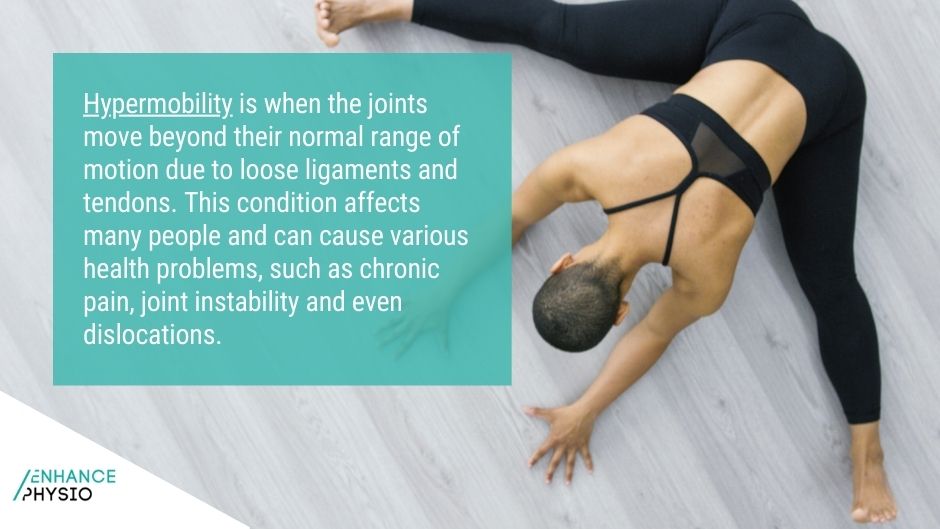Do you have joints that move beyond their normal range of motion? Do you often experience pain and discomfort in your joints? If yes, you may be suffering from hypermobility.
Hypermobility is when the joints move beyond their normal range of motion due to loose ligaments and tendons. This condition affects many people and can cause various health problems, such as chronic pain, joint instability and even dislocations.
Fortunately, physiotherapy can help manage the symptoms and improve the quality of life for individuals with hypermobility.
Physiotherapy is a non-invasive treatment that focuses on restoring the body’s normal function. It involves exercises, stretches, and other techniques that help strengthen the muscles and improve joint stability. If you have hypermobility, physiotherapy can be an effective treatment option to alleviate pain and improve your overall mobility.
What is hypermobility?
Our joint range of motion is variable within the population. When we describe hypermobility (which is known as more movement than “normal”) of a joint, this is measured against what we know is average for a person’s age and gender, shown on a bell curve. Some people have a “normal” range, significantly more than the population average. This movement is seen to be “hypermobile” compared to the average population. It can be quite “normal” for that person as many variables can contribute to joint mobility.
A comparison of joint mobility is our height. We have average heights that are “normal” for gender and age; however, those that fall above or below those averages are not usually seen as “problematic”.
Hypermobile joints are highly prevalent in the population. Some of these are related to conditions/syndromes that cause other problems. Having a hypermobile joint or even multiple joints does NOT always mean you have one of these conditions/syndromes however having them is characteristic of people with the conditions/syndromes.
Hypermobility can occur on its own or as a symptom of a variety of conditions, including:
- Ehlers-Danlos syndrome
- Rheumatoid arthritis
- Down syndrome
- Benign joint hypermobility syndrome
- Marfan syndrome

Common symptoms of hypermobility
Hypermobility can be asymptomatic and cause no problems or concerns, but it can also cause a variety of symptoms, including:
- Early fatigue, such as a sore writing hand.
- Joint sprains that reoccur.
- Scoliosis.
- Subluxations and dislocations caused by joint laxity and instability.
- Early-onset arthritis caused by joint cartilage damage.
- Clicking and locking joints.
- Bursitis, frequent tendon pain
- Joint discomfort
Physiotherapy assessment and diagnosis for hypermobility
Your physiotherapist will assess you using a combination of tests and will most likely include the most commonly reported measurement tool called the Beighton Score, which is a numerical score from 0-9 to access for joint hypermobility with 1 point given to each positive test, this is then reported against your age & gender.
These tests are used to assist in differentiating between those with and without Generalised Joint Hypermobility (GJH). If you have concerns about hypermobility in your joints, it’s best to book in with your Physiotherapist to be reviewed and determine the requirements of an appropriate treatment plan.
Benefits of Physiotherapy for Hypermobility
- Manual therapy and soft tissue massage are two methods for pain management.
- Our exercise programs are personalised to your needs and can be done independently. They are customised to address your specific condition to guarantee safety and optimal results.
Proprioception exercises: Proprioception is the ability of your brain to detect the location of your joints at any particular time. Individuals with Joint Hypermobility Syndrome improved significantly in proprioception after an 8-week closed kinetic chain training program, improving pain and quality of life.
Stretching exercises can be beneficial in managing hypermobility; they help to increase flexibility and reduce the risk of injury. Regularly stretching areas such as the hips, legs, back, and shoulders can improve joint stability and strengthen the muscles that support them.
Dynamic control exercises to train optimal movement patterns, especially at the shoulder and lower back/hip.
Strengthening exercises help to strengthen the muscles and increase muscle tone, which helps with joint stability.
- Hydrotherapy can be an effective means of providing therapy for hypermobile patients. Water’s buoyancy aids in relieving compression in sore joints.
- You will receive personalised advice and education based on your needs and goals. This may involve suggestions for adjusting your physical activities, strategies for resuming sports or work, and alternatives for managing pain.

Final Thoughts on Physiotherapy for Hypermobility
Physiotherapy can’t cure hypermobility, but it can effectively manage its symptoms and lead to a better quality of life in the long run.
If you or someone you know is struggling with hypermobility, don’t hesitate to give physiotherapy a try. With the right treatment plan, you can gain strength, reduce pain, and improve your overall quality of life.
Remember: you don’t have to live with the limitations of hypermobility forever. Seek out help and take control of your health today!





